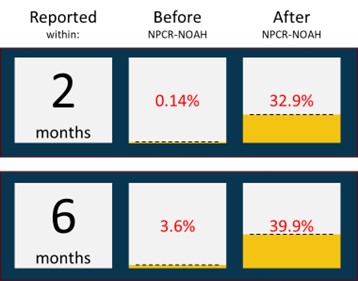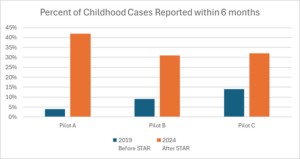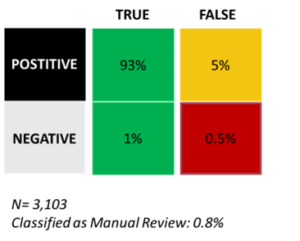
The Centers for Disease Control and Prevention (CDC) is working on an ambitious initiative to increase the speed and accuracy of reporting pediatric, adolescent, and young adult cancer cases from diagnosis and treatment centers to central cancer registries. The Childhood Cancer STAR Project (STAR Project) stems from the 2018 congressional law, the Childhood Cancer Survivorship, Treatment, Access, and Research (STAR) Act, designed to help reduce the burden of childhood cancer. Staff in CDC’s National Program of Cancer Registries (NPCR) lead the project.
The STAR Project team partnered with four states to pilot an improved reporting infrastructure and processes.
The new infrastructure aims to track cancer epidemiology in young populations more effectively and connect patients with clinical trials, resources, and support networks.
Rapid Reporting Infrastructure With NPCR-NOAH
The NPCR’s National Oncology rapid Ascertainment Hub (NPCR-NOAH) is central to the STAR Project’s success. This cloud-based ePath infrastructure is designed to streamline data standardization, automate validation, and enhance case finding and analytics. Its key features include:
- A scalable, flexible, and accessible cloud-based architecture.
- A secure, HIPAA-compliant data platform with end-to-end encryption.
- Evaluation of multiple natural language processing models.
- Data standardization, validation, and case finding using natural language processing.
- Data conversion from HL7 2.3.1, HL7 2.5.1, and standardized flat file formats to a North American Association for Central Cancer Registries (NAACCR)-compliant HL7 2.5.1 volume 5, version 4 file.
- Web portals for assessing case finding accuracy and monitoring performance.
- Support for the revised pipe-delimited flat file reporting standard published by the NAACCR Pathology Work Group.
The Solution National Program of Cancer Registries – National Oncology rapid Ascertainment Hub (NPCR-NOAH) Architecture Framework
Figure 1: Diagram of the NPCR-NOAH solution architecture framework.
NPCR-NOAH Improves Reporting Timeliness
The project has achieved notable milestones, including successfully piloting NPCR-NOAH with three state central cancer registries. After implementing NPCR-NOAH, the percentage of cases reported within 60 days of first contact increased from less than 1% to 33% for all three registries.
Figure 2: Abstract reporting timeliness before and after NPCR-NOAH was implemented.
Other Rapid Reporting Strategies Improve Timeliness
Participating registries adopted several strategies to improve reporting timeliness. These included the concurrent abstracting requirement, which permits the submission of NAACCR-modified abstracts, and the implementation of suspense list reporting with a minimum required dataset. They also provided timeliness reports to help hospital registries evaluate their performance.
Pilot A focused on monthly submissions from facilities and prioritized abstracting cases for the 0 to 29 age group. Pilot B concentrated on sharing performance metrics and introduced the concurrent abstracting requirement for NAACCR-modified abstracts. Pilot C tested suspense list reporting with a minimum dataset and, in 2023, implemented NPCR-NOAH.
Figure 3: Percentage of abstracts for patient ages 0 to 29 years reported within six months of first contact at the beginning and end of the STAR Project evaluation period.
Scalable Framework for Auditing Case Finding Results Developed
Systems that perform case finding must be audited to validate the accuracy of their results. An efficient and scalable way of analyzing and collecting the results was needed, so the team developed the NPCR-NOAH Certified Tumor Registrar Observation Portal. The portal is a secure web application where subject matter experts (SMEs) tested the system in collaboration with the Nebraska Cancer Registry.
The team also created the Metrics Portal to provide insights into accuracy and dataset scope. Using the Observation Portal, SMEs manually reviewed NPCR-NOAH’s case-finding results to determine which reports were correctly classified as reportable, nonreportable, or requiring review. After examining more than 3,100 records across three pilot studies, NPCR-NOAH achieved a case-finding accuracy rate of 94%.
Figure 4: NPCR-NOAH case-finding results from three pilot studies.
A Step Toward Broader Data Modernization Initiatives in Public Health Surveillance
The STAR Project is a pioneering effort in adopting cloud computing systems for childhood cancer reporting.
Work completed by the STAR Project team and its partners has identified essential needs to move forward from the pilot phase to full-scale implementation. This includes integrating NPCR-NOAH with CDC’s larger data modernization initiative and NPCR’s cloud-based computing platform. The integrated systems will be a strong foundation and infrastructure for rapid electronic reporting, as well as a valuable model for future data modernization initiatives in public health.
The STAR Project Team Members and Additional Authors include: Kasey Diebold, MS; Sandy Jones, Richard Batson, MBA, PMP, CSM; Dave Butterworth, MPA, MSP; Kimiko S. Sanders, MPA; Erin K. Stair, MD, MPH
Tags: CDC, Cancer registries, Featured, NPCR-NOAH, STAR Project
What to Read Next
NAACCR Board of Directors Spearheads Review of NAACCR Certification Standards
Since 1998, NAACCR has evaluated annual data submissions from central cancer registries as part of the NAACCR certification process. Over…
NAACCR Participates in the USCDI+ Cancer Research Data Exchange Summit
On May 8th and 9th, the U.S. Office of the National Coordinator for Health Information Technology (ONC) and other federal…
NAACCR December 2023 Call for Data Update
NAACCR has completed the data quality assessments of the December 2023 Call for Data (CFD) Submission File. We will be…









